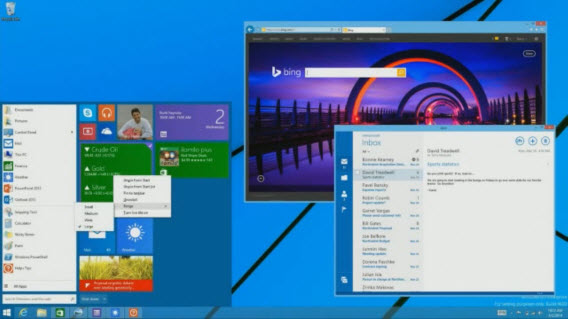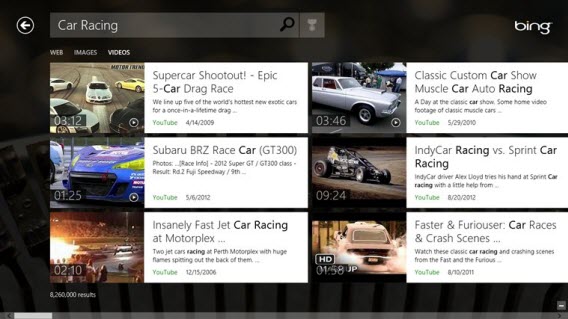Article
One Windows: what to expect from the next big Windows update

- May 3, 2014
- Updated: July 2, 2025 at 7:42 AM

After one update, another follows swiftly in its wake. Hot on the heels of the release of Windows 8.1 Update 1, the rumor factory is in full swing for Windows 8.1 Update 2, Windows 8.2, and Windows 9.
Here’s an overview of the half-truths we know already.
The next update: Windows 8.2 or Windows 8.1 Update 2
According to recent media reports, Microsoft is planning another update for Windows 8, to be released in August 2014. Whether it’ll be released as Windows 8.2, or Windows 8.1 Update 2, is still unclear.
Once again, the source of the rumors is the Russian hacker group WZor, which has already attracted attention in the past with its accurate predictions. Mary Jo Foley of ZDNet, who has contacts in Microsoft, has also talked about a further update for the summer.
Little is known, however, about the expected innovations. At the BUILD conference, Microsoft demonstrated Windows Store apps (Metro Apps) in windowed mode, and a fully functional Start menu.
According to WZor, the future Start menu will work differently on touch screen devices compared to regular Desktop PCs. Other sources speak of a Start menu design optimized for swiping on touch devices.

As Mary Jo Foley reports, if possible, Microsoft plans to offer both innovations in the August update. Technically, that should be easily achievable for the Start menu: the technology is not new, nor is it particularly complex.
In windowed mode for Windows Store Apps, things already look rather different. At last, these apps have been optimized for full screen view. Stardock has already proven with ModernMix software that it all still works.
Windows 9
We know almost nothing about Windows 9, other than its targeted release date of April 2015, and a probable new version of the Modern Surface UI.
If the Start menu and windowed mode for Windows Store apps don’t make it into the fall update, these would be two significant innovations for Windows 9. Long before BUILD 2014, you could already look at interesting Windows 9 concepts on YouTube and sites like DeviantART, mostly with Start Menu and Windows Store apps in windowed mode.
It seems that Microsoft is bowing to pressure from users. For a large version upgrade, this wouldn’t be good enough, which means that we can count on further big innovations.
Windows for free
There were more rumors from WZor that Microsoft would be offering a free, stripped-down version of Windows as a kind of cloud OS. The user would then unlock advanced features through a type of subscription, just like for Office 365, via an internet connection.
Other sources have already talked about a possible free version of Windows. According to them, Microsoft was experimenting with a version called “Windows 8.1 with Bing,” which Microsoft could give away to Windows 7 users.

These reports most likely weren’t plucked out of thin air. Microsoft is now pursuing an aggressive strategy and is offering ever more products at knock-down prices or completely free. As announced at the BUILD 2014 conference, it seems as if devices with screens smaller than 9 inches will have Windows for free.
In February, a 70 percent price reduction for Windows 8.1 on cheap computers and tablets made headlines, and back in December, rumors were already circulating about free versions of Windows Phone and Windows RT. For some smartphone makers, this has been a reality since March. Even the big crowd-puller, Office 2013, has been available free for mini-tablets since mid-2013.
One Windows: Merger of Windows RT and Windows Phone
Ever since the release of Windows 8, Microsoft has been working on merging Windows Phone and Windows 8. They started with aligning the interface. Both rely on visual tiles and the design known as Modern UI, which was first introduced with Windows Phone. This is all part of Microsoft’s long-term strategy.
Technically, aligning the systems is anything, but simple. Chip architecture and user requirements differ dramatically in smartphones, tablets, and desktop PCs. Currently, Microsoft is focused on the alignment of Windows Phone and Windows RT, where Windows RT represents the Modern UI and app ecosystem of Windows 8.
With the recently released Windows Phone SDK, developers can easily design apps for both ecosystems simultaneously.

Microsoft, however, isn’t content with this progress. As Microsoft’s chief operating system division head Terry Myerson revealed in an interview, the Redmond company is also planning to align the developer tools for other platforms.
Under the strategy One Windows, the software giant is working on a standardized development environment for all App types on Xbox, tablets, smartphones, and cloud services.
The extent to which Microsoft will bring together – or is capable of bringing together – desktop and Windows Store apps remains unclear. Perhaps the classic desktop apps will be allowed to slowly die out through continuous development of the new app model.
Related Articles
You may also like
 News
NewsThe group of cyber threats that uses smart contracts to distribute malware
Read more
 News
NewsThe co-creator of Mortal Kombat warns that the first scene of the new movie is going to make us cry buckets
Read more
 News
NewsThe next season of Diablo 4 will have all these changes that you don't expect
Read more
 News
NewsMeta updates brand safety features
Read more
 News
NewsThis Christmas movie is everything you need to watch and get excited about with your family
Read more
 Article
ArticleHBO Max presents the French reinterpretation of a classic novel in its upcoming series
Read more